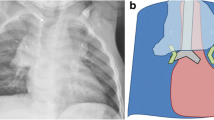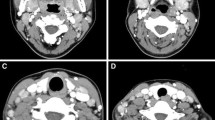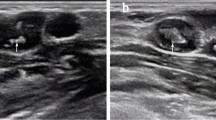Abstract
Background: Radiographic demonstration of mediastinal lymphadenopathy is important for the diagnosis of pulmonary tuberculosis (PTB). Plain radiographs are unreliable for this and CT, which is relatively more expensive and carries a high radiation burden, remains the gold standard. No studies correlating the presence of axillary with mediastinal lymphadenopathy have been reported. Such a correlation would allow for clinical or ultrasound diagnosis of PTB via the axilla. Objective: To correlate the presence of axillary lymphadenopathy with mediastinal lymphadenopathy in children with suspected PTB. Materials and methods: CT scans were performed and reviewed in 100 children (prospectively recruited) with suspected PTB. The axilla and mediastinum were reviewed separately by covering the non-relevant sections on the CT scans prior to reading. Only nodes greater than 1 cm were regarded as pathological. Results: Mediastinal lymphadenopathy was present in 46% of children; 70% had lymphadenopathy in either axilla. Bilateral axillary lymphadenopathy was identified in 47%. Axillary lymphadenopathy showed a sensitivity of 74% and a specificity of 33% for the presence of mediastinal adenopathy. Bilateral axillary adenopathy had a sensitivity of 50% and a specificity of 56%. Conclusions: Axillary lymphadenopathy has a moderate sensitivity and low specificity for the presence of mediastinal and hilar lymphadenopathy in children with suspected PTB. Further research should be aimed at correlating ultrasound-detected axillary lymphadenopathy with FNA results in children.





Similar content being viewed by others
References
Andronikou S, Joseph E, Lucas S, et al (2004) CT scanning for the detection of tuberculous mediastinal and hilar lymphadenopathy in children. Pediatr Radiol 34:232–236
Delacourt C, Mani TM, Bonnerot V, et al (1993) Computed tomography with a normal chest radiograph in tuberculous infection. Arch Dis Child 69:430–432
World Health Organisation (1983) The worldwide magnitude of protein-energy malnutrition: an overview from the World Health Organisation. Provisional guidelines for the diagnosis and classification of the EPI target diseases for primary health care, surveillance and special studies
Lamont AC, Cremin BJ, Pelteret RM (1986) Radiological patterns of pulmonary TB in the paediatric age group. Pediatr Radiol 16:2–7
Salazar GE, Schmitz TL, Cama R, et al (2001) Pulmonary tuberculosis in children in a developing country. Pediatrics 108:448–453
Schaaf HS, Beyers N, Gie RP, et al (1995) Respiratory tuberculosis in childhood: the diagnostic value of clinical features and special investigations. Pediatr Infect Dis J 14:189–194
Correa AG (1977) Unique aspects of tuberculosis in the paediatric population. Clin Chest Med 18:89–98
Agrons GA, Markowitz RI, Kramer SS (1993) Pulmonary tuberculosis in children. Semin Roentgenol 28:158–172
Parisi MT, Jensen MC, Wood BP (1994) Pictorial review of the usual and unusual roentgen manifestations of childhood tuberculosis. Clin Imaging 18:149–154
Leung AN, Muller NL, Pineda PR, et al (1992) Primary tuberculosis in childhood: radiographic manifestations. Radiology 182:87–91
Neu N, Saiman L, San Gabriel P, et al (1999) Diagnosis of pediatric TB in the modern era. Pediatr Infect Dis J 18:122–126
Palmer PE (1979) Pulmonary tuberculosis—usual and unusual radiographic presentations. Semin Roentgenol 14:204–243
Andronikou S (2002) Pathological correlation of CT-detected mediastinal lymphadenopathy in children: the lack of size threshold criteria for abnormality. Pediatr Radiol 32:912
Quint LE, Glazer GM, Orringer MB, et al (1986) Mediastinal lymphnode detection and sizing at CT and autopsy. AJR 147:469–472
Platt JF, Glazer GM, Orringer MB, et al (1988) Radiologic evaluation of the subcarinal lymph nodes: a comparative study. AJR 151:279–282
Priel I, Dolev E (1982) Tuberculous lymphadenitis: a survey of 94 cases. J Infect Dis 146:710
Dandapat MC, Mishra BM, Dash SP, et al (1990) Peripheral lymph node tuberculosis: a review of 80 cases. Br J Surg 77:911–912
Chatterji DN (1975) Superficial lymphadenitis in children with intrathoracic tuberculosis. J Indian Med Assoc 64:95–97
McMaster P, Isaacs D (2000) Critical review of evidence for short course therapy for tuberculous adenitis in children. Pediatr Infect Dis J 19:401–404
Author information
Authors and Affiliations
Corresponding author
Rights and permissions
About this article
Cite this article
Theron, S., Andronikou, S. Comparing axillary and mediastinal lymphadenopathy on CT in children with suspected pulmonary tuberculosis. Pediatr Radiol 35, 854–858 (2005). https://doi.org/10.1007/s00247-005-1490-y
Received:
Revised:
Accepted:
Published:
Issue Date:
DOI: https://doi.org/10.1007/s00247-005-1490-y




